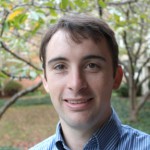| Sarit Agasti | Jawaharlal Nehru Centre for Advanced Scientific Research, India |
 |
Sarit received his Bachelor’s degree in Chemistry from the University of Calcutta, in 2003 and then his Master’s degree from the Indian Institute of Technology, Kanpur in 2005. Sarit went on to receive his PhD from the University of Massachusetts at Amherst under the supervision of Professor Vincent M. Rotello. Since his PhD, he has been a Postdoctoral Fellow at both the Massachusetts General hospital-Harvard Medical School and the Wyss Institute at Harvard University working with Professor Ralph Weissleder and Professor Peng Yin, respectively. Sarit has now returned to India and is working as a Faculty fellow at the Jawaharlal Nehru Centre for Advanced Scientific Research. His lab is interested in engineering small molecules and programmable molecular materials to address challenges in bioimaging, specifically in super-resolution microscopy. Some of his previously published work in Royal Society of Chemistry journals is below.
A photoactivatable drug–caged fluorophore conjugate allows direct quantification of intracellular drug transport Direct photopatterning of light-activated gold nanoparticles |
| Athina Anastasaki | Warwick University, UK |
 |
Athina received her Bachelor’s degree in Chemistry from the National and Kapodistrian University of Athens. She then undertook a PhD in Polymer Chemistry at the University of Warwick under the supervision of Professor David Haddleton. Athina is currently a Monash-Warwick Alliance Research Fellow in the research groups of Professor David Haddleton and Professor Thomas Davis, focusing on controlled living radical polymerization methods, mechanistic studies, photochemistry and sequence-controlled polymers. Some of her recently published work in Royal Society of Chemistry journals is below.
Photo-induced living radical polymerization of acrylates utilizing a discrete copper(II)–formate complex Photoinduced sequence-control via one pot living radical polymerization of acrylates |
| Robert Chapman | Imperial College London, UK |
 |
Robert received his Bachelor’s degree from the University of New South Wales and then spent a year as an Associate Consultant for the Boston Consulting Group before returning to academia to complete his PhD at the University of Sydney under the supervision of Professors Sébastien Perrier and Katrina Jolliffe. Since his PhD, Robert has been based at Imperial College London as a Postdoctoral Research Associate working with Professor Molly Stevens on nanoparticle based biosensors and polymer scaffolds for tissue engineering. Some of his recently published work in Royal Society of Chemistry journals is below.
Synthesis and self-assembly of temperature-responsive copolymers based on N-vinylpyrrolidone and triethylene glycol methacrylate |
| Chaohua Cui | Soochow University, China |
 |
Chaohua received his Bachelor’s degree from the Beijing Institute of technology in 2009 and then went on to receive his Master’s degree from the Beijing University of Chemical Technology in 2011. Chaohua completed his PhD in 2014 from the Hong Kong Baptist University under the supervision of Professor Wai-Yeung Wong. Since his PhD, Chaohua has been working at Soochow University investigating organic solar cells. Some of his recent publications in Royal Society of Chemistry journals are below.
Cooperative assembly of an active layer utilizing the synergistic effect of a functional fullerene triad as an acceptor for efficient P3HT-based PSCs Improvement of open-circuit voltage and photovoltaic properties of 2D-conjugated polymers by alkylthio substitution |
| Rebecca Gieseking | Northwestern University, USA |
 |
Rebecca received both her Bachelor’s and Master’s degrees from Furman University; she then went on to receive her PhD from the Georgia Institute of Technology under the supervision of Professor Jean-Luc Brédas. Rebecca is now a Postdoctoral fellow at Northwestern University working with Professors George Schatz and Mark Ratner researching photoinduced electron transfer in plasmonic systems. Some of Rebecca’s previous publications in Royal Society of Chemistry journals are below.
Polymethine materials with solid-state third-order optical susceptibilities suitable for all-optical signal-processing applications Complementary halogen and hydrogen bonding: sulfur⋯iodine interactions and thioamideribbons |
| Peter Korevaar | Harvard University, USA |
 |
Peter received both his Bachelor’s and Master’s degree from Eindhoven University of Technology before also completing his PhD at Eindhoven University of Technology under the supervision of Professor E. W. Meijer in 2014. Since his PhD Peter has been a Postdoctoral researcher at both Eindhoven University of Technology and more recently at Harvard University working with Professor J. Aizenberg researching the development of adaptive materials. Some of his recent publications in Royal Society of Chemistry journals are below.
The influence of π-conjugated moieties on the thermodynamics of cooperatively self-assembling tricarboxamides Small sized perylene-bisimide assemblies controlled by both cooperative and anti-cooperative assembly processes |
| John Labram | University of California at Santa Barbara, USA |
 |
John received his Undergraduate degree in Physics from the University of Warwick and then went on to receive his PhD in Solid State Physics from Imperial College London under the supervision of Prof. Thomas Anthopoulos. John took a break from research for 18 months working for the Royal Bank of Scotland before returning to research at Imperial College London in 2013. Since the end of 2014, John has been an Elings Fellow at the University of California Santa Barbara working on organometal halide perovskite devices. Some of his recent publications in Royal Society of Chemistry journals are below.
Distinguishing the influence of structural and energetic disorder on electron transport in fullerene multi-adducts Synthesis of tetraselenophenoporphyrazine and its application in transistor devices |
| Tian-Yi Ma | University of Adelaide, Australia |
 |
Tian-Yi received both his Bachelor’s degree and PhD from Nankai University in 2008 and 2013, respectively. Since 2013 Tian-Yi has been at the University of Adelaide in the School of Chemical Engineering, as an Australian Research Council Discovery Early Career Researcher Award (ARC DECRA) fellow, developing high-performance electrocatalysts in metal-air batteries and water splitting devices on the basis of organic polymer, carbon, transition-metal, metal-organic framework materials. Some of his recent publications in Royal Society of Chemistry journals are below.
Porous P-doped graphitic carbon nitride nanosheets for synergistically enhanced visible-light photocatalytic H2 production Mesoporous MnCo2O4 with abundant oxygen vacancy defects as high-performance oxygen reduction catalysts |
| Jaime Martín Perez | Imperial College London, UK |
 |
Jaime received his Bachelor’s degree in 2005 from the University of the Basque Country before receiving his PhD from the Institute of Polymer Science, Spanish National Research Council (CSIC) in 2010. Since his PhD, Jaime he was a research associate at both the National Centre for Microelectronics, CSIC and Imperial College London, where he is now a Maria Sklodowska-Curie Individual Fellow working on confinement effects in polymer materials and solution processing of organic photonic crystals. Some of his previous publications in Royal Society of Chemistry journals are below.
Decrease in thermal conductivity in polymeric P3HT nanowires by size-reduction induced by crystal orientation: new approaches towards thermal transport engineering of organic materials The use of PEEK nanorod arrays for the fabrication of nanoporous surfaces under high temperature: SiNx example |
| Troy Townsend | St. Mary’s College of Maryland, USA |
 |
Troy received his Bachelor’s in Chemistry and Biology from St Mary’s College of Maryland; he then spent a year as a High School Chemistry teacher before completing his PhD in Inorganic Chemistry under the supervision of Professor Frank Osterloh in 2012. Troy spent two years as a Postdoctoral fellow at the US Naval Research Laboratory before returning to St Mary’s College of Maryland as a visiting Assistant Professor of Chemistry as well as researching solution processing of nanocrystal electronics. Some of Troy’s recent publications in Royal Society of Chemistry journals are below.
Safer salts for CdTe nanocrystal solution processed solar cells: the dual roles of ligand exchange and grain growth Fully solution processed all inorganic nanocrystal solar cells |
| Daiki Umeyama | Stanford University, USA |
 |
Daiki received his Bachelor’s and Master’s degree, as well as his PhD, from Kyoto University. Since the completion of his PhD in early 2015 he has been working as a Postdoctoral research fellow at Stanford University investigating functional properties of halide hybrid perovskites. Some of Daiki’s previous publications in Royal Society of Chemistry journals are below.
Glass formation via structural fragmentation of a 2D coordination network Template-directed proton conduction pathways in a coordination framework |
| Mengye Wang | Xiamen University, China |
 |
Mengye received both her Bachelor’s degree and PhD from Xiamen University under the supervision of Professor Changjian Lin. She was also a visiting PhD student at the Georgia Institute of Technology working under the supervision of Professor Zhiqun Lin, completing her PhD in early 2015. She is now researching advanced nano-materials for energy related application at Xiamen University. Some recent publications from Mengye in Royal Society of Chemistry journals are below.
An external template-free route to uniform semiconducting hollow mesospheres and their use in photocatalysis Inorganic-modified semiconductor TiO2 nanotube arrays for photocatalysis |
Up close and personal with the Materials Horizons Community Board
03 Nov 2015
By Abigail Hallowes.
Biographies of our newest board members










